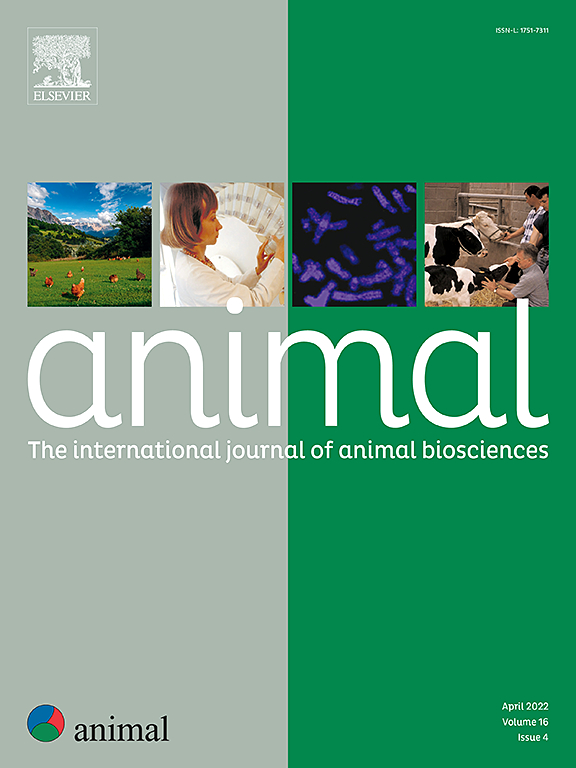Effect of terminal sire line on heat stress responses in growing-fattening pigs selected for optimal growth rate vs optimal carcass quality
IF 4.2
2区 农林科学
Q1 AGRICULTURE, DAIRY & ANIMAL SCIENCE
引用次数: 0
Abstract
Management of heat stress in animal husbandry is becoming more important as the number and intensity of heat waves increase due to climate change. Pigs are more sensitive to heat than other animals but show individual differences. Could these differences be traced to sire lines used in Europe? In the present study, the influence of terminal sire line on heat stress−related parameters was investigated to better understand genotype-environment interactions with the aim of improving heat stress resilience in commercial growing-finishing pigs. In total, 360 fattening pigs in three consecutive batches were divided at weaning into pens of five piglets of the same genetic background. The animals were progeny of TN70 sows × a terminal sire line selected for either optimal growth rate (Sgrowth, homozygous stress negative MaxiMus sire line) or optimal carcass quality (Scarcass, homozygous stress positive Belgian Piétrain sire line). Pigs were monitored from 10 weeks of age (25.2 ± 0.4 kg) until slaughter age (118.4 ± 0.7 kg) during the summer of 2022. Respiration rate, rectal temperature and passive behaviour were evaluated during days with a high heat load (predicted outdoor temperature ≥ 28 °C, Temperature-Humidity index (THI) ≥ 75) and thermoneutral days (THI < 75). Blood parameters were evaluated in batch 3 during an artificially induced 7-day heat wave at 21 weeks of age. The expected phenotypic differences between the terminal sire types could be confirmed, with faster growth in Sgrowth pigs (1 003 vs 923 g/day, P < 0.001) and better carcass quality in Scarcass pigs (67.3 vs 61.7 mm lean meat thickness, P < 0.001). Rectal temperature and respiration rate showed no significant differences among sire lines as heat load increased (ΔTHI × sire line, P > 0.05). Regardless of genetic background, physiological parameters were influenced by weight: heavier pigs showed faster increases in rectal temperature and respiration rate with rising THI in comparison to lighter pigs (interaction term ΔTHI × weight, P < 0.001). Daily gain of Scarcass pigs dropped as heat load duration increased, whereas daily gain of Sgrowth pigs either remained fairly stable or increased (sire line × NDT (number of days when THI ≥ 77 within a week), P = 0.020). Future research should focus on identifying a terminal sire line that combines steady growth under high heat loads with optimal performance traits such as feed conversion ratio and carcass quality.
终末父系对最佳生长率与最佳胴体品质选择的生长育肥猪热应激反应的影响
随着气候变化导致的热浪数量和强度的增加,对畜牧业热应激的管理变得越来越重要。猪比其他动物对热更敏感,但表现出个体差异。这些差异可以追溯到欧洲使用的父系吗?为了更好地了解基因型与环境的相互作用,提高商品生长肥育猪的热应激恢复能力,本研究研究了终端父系对热应激相关参数的影响。在断奶时,360头育肥猪连续3批次被分成5头遗传背景相同的仔猪。试验动物为TN70母猪x的后代,这是一种选择生长速度最佳(Sgrowth,纯合胁迫负的MaxiMus父系)或胴体质量最佳(Scarcass,纯合胁迫正的比利时pisamutrain父系)的终端父系。在2022年夏季对10周龄(25.2±0.4 kg)至屠宰龄(118.4±0.7 kg)的猪进行监测。在高热负荷(预计室外温度≥28°C,温湿度指数(THI)≥75)和热中性(THI < 75)的日子里,评估呼吸速率、直肠温度和被动行为。在第3批21周龄人工诱导的7天热浪中评估血液参数。终端父系之间预期的表型差异可以得到证实,生长猪的生长速度更快(1 003 g/d vs 923 g/d, P < 0.001),瘦猪的胴体质量更好(瘦肉厚度67.3 mm vs 61.7 mm, P < 0.001)。随着热负荷的增加,各父系间直肠温度和呼吸速率无显著差异(ΔTHI ×父系,P > 0.05)。无论遗传背景如何,生理参数都受到体重的影响:与体重较轻的猪相比,体重较重的猪直肠温度和呼吸速率随THI升高的速度更快(相互作用项ΔTHI ×体重,P < 0.001)。瘦猪的日增重随着热负荷持续时间的增加而下降,而生长猪的日增重则保持相当稳定或有所增加(父系× NDT(一周内THI≥77的天数),P = 0.020)。未来的研究应侧重于寻找一种既能在高热负荷下稳定生长,又能获得最佳性能性状(如饲料系数和胴体质量)的终端父系。
本文章由计算机程序翻译,如有差异,请以英文原文为准。
求助全文
约1分钟内获得全文
求助全文
来源期刊

Animal
农林科学-奶制品与动物科学
CiteScore
7.50
自引率
2.80%
发文量
246
审稿时长
3 months
期刊介绍:
Editorial board
animal attracts the best research in animal biology and animal systems from across the spectrum of the agricultural, biomedical, and environmental sciences. It is the central element in an exciting collaboration between the British Society of Animal Science (BSAS), Institut National de la Recherche Agronomique (INRA) and the European Federation of Animal Science (EAAP) and represents a merging of three scientific journals: Animal Science; Animal Research; Reproduction, Nutrition, Development. animal publishes original cutting-edge research, ''hot'' topics and horizon-scanning reviews on animal-related aspects of the life sciences at the molecular, cellular, organ, whole animal and production system levels. The main subject areas include: breeding and genetics; nutrition; physiology and functional biology of systems; behaviour, health and welfare; farming systems, environmental impact and climate change; product quality, human health and well-being. Animal models and papers dealing with the integration of research between these topics and their impact on the environment and people are particularly welcome.
 求助内容:
求助内容: 应助结果提醒方式:
应助结果提醒方式:


